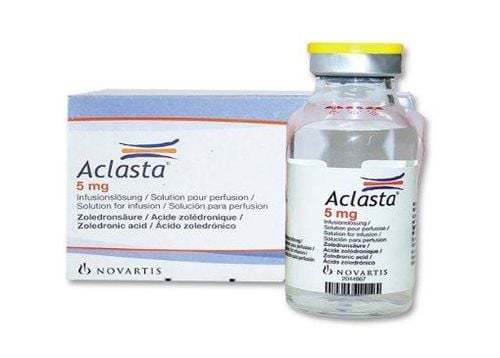This is an automatically translated article.
Alovell is often prescribed by doctors to treat osteoporosis for the elderly, postmenopausal women or other at-risk populations. Before and during treatment with Alovell, patients should carefully read the instructions for use of the drug and follow all instructions given by the doctor.
1. What is Alovell?
Alovell drug belongs to the group of analgesics - antipyretics, used to treat osteoporosis in postmenopausal women or the elderly, and effectively reduce the risk of fractures. Currently, Alovell is manufactured by PT. Novell Pharmaceutical Laboratories – Indonesia in tablet dosage form. In each box of Alovell, there will be 1 blister x 4 tablets with the main active ingredient being alendronic acid (in the form of alendronate sodium) with a content of 70mg.
Active ingredient Alendronate acts as an Amino Bisphosphonate capable of inhibiting specific bone resorption. A number of clinical studies have shown that alendronate tends to selectively accumulate in areas of active bone resorption, thereby preventing osteoclasts.
Preclinical treatment with Alendronate resulted in a significant increase in bone mass in the femoral neck, vertebral column and trochanter. For postmenopausal women aged 40-85 years with osteoporosis, after about 3 years of treatment with Alovell, there was a significant reduction in the number of vertebral fractures. On the other hand, bone mineral density was also found to have a marked increase after only 3 months of taking Alovell and continued to increase during treatment.
However, if after 1-2 years of treatment with Alovell and the drug is stopped, the increase in bone mass is no longer maintained. This shows that, in order to maintain the effectiveness of osteoporosis treatment, patients need to be treated daily with Alovell.
2. Indications and contraindications for the use of Alovell
2.1. Indications to use Alovell Alovell is usually prescribed by doctors for the following cases:
Treatment and prevention of osteoporosis. Treatment to increase bone mass in men with osteoporosis. Paget's disease of bone. Reducing the risk of osteoporosis fractures in the elderly and pregnant women. 2.2. Contraindication to the use of Alovell Alovell should not be used in patients who have not been prescribed by a specialist:
Patients with allergies or a history of hypersensitivity to Alendronate active ingredients or any any excipients in the drug. The patient has anomalies in the esophagus that slow down the expansion of the esophagus, such as spasm or narrowing of the esophageal sphincter. Patient is not able to sit upright or stand for 30 minutes. The patient has hypocalcemia.
3. Dosage and how to use Alovell
3.1. Dosage of Alovell as recommended Dosage for osteoporosis treatment for elderly patients and postmenopausal women with Alovell is 70mg / time / week. No dose adjustment is required for subjects such as patients with mild to moderate renal or hepatic impairment.
3.2. How to use Alovell medicine Alovell is made in the form of tablets, so patients can take it orally. Patients should swallow the tablet whole with a glass of water from 180-240ml in the morning when they wake up or at least 30 minutes before eating. Absolutely do not lie down immediately after taking Alovell medicine.
If you miss a dose of Alovell, you can make up for it the next morning. Avoid taking 2 pills in the same day. In addition, patients also need to apply the correct dose of Alovell recommended on the package or as directed by the doctor. Absolutely do not arbitrarily use the drug, adjust the dose or stop treatment without the approval of the doctor.
4. Side effects when taking Alovell
During the treatment of osteoporosis with Alovell, patients are at risk of experiencing some of the following side effects:
Very common side effects: Joint pain, bone pain or muscle pain. Common side effects: Dyspepsia, abdominal pain, headache, diarrhea, constipation, esophageal ulceration, gastric acid reflux, dysphagia, hair loss, itching, joint swelling, peripheral edema, fatigue or weakness weakness. Uncommon side effects: scleritis, uveitis, episcleritis, vomiting, nausea, dysgeusia, gastritis, esophagitis, esophagitis, black stools, skin redness, rash skin rash, muscle pain, fever, malaise. Rare adverse reactions: pruritus, urticaria, esophageal stricture, upper gastrointestinal ulceration/perforation/hemorrhage, oropharyngeal ulceration, symptomatic hypocalcaemia, increased photosensitivity of the skin, Stevens syndrome- Johnson syndrome, toxic epidermal necrolysis, stress fracture, long stem fracture, osteonecrosis of the jaw, or atypical subtrochanteric fracture. Very rare side effects: Osteonecrosis of the outer ear canal. Usually, the side effects that occur when taking Alovell will go away on their own when the patient stops treatment. However, some reactions can be more severe and leave sequelae if not treated promptly. Patients should notify their doctor as soon as possible if any adverse effects occur during treatment with Alovell.
5. What precautions should be taken while using Alovell?
Careful consideration should be given before treating with Alovell to the following subjects:
Children under 15 years of age. Elderly. Pregnant women. Women are breastfeeding. People with kidney or liver failure. People who are sensitive or at risk of being allergic to any of the ingredients in the drug. People with hepatic coma. People with myasthenia gravis. People with stomach ulcers. The use of Alvovell may cause side effects of varying frequency, such as visual disturbances, headache, bone, muscle or joint pain. These symptoms may affect the patient's ability to drive and use machines.
6. What drugs can Alovell interact with?
The following is a list of drugs that may interact with Alovel:
The concomitant use of Alovell with hormone replacement therapy and Alendronate in postmenopausal women has not been established. Therefore, the simultaneous use of these two drugs is not recommended. Antacids and calcium supplements when taken with Alovell may reduce the absorption of Alendronate. Therefore, patients should wait at least 30 minutes after taking Alendronate before taking any other substances. Aspirin may cause undesirable gastrointestinal side effects when used concomitantly with Alovell. Nonsteroidal anti-inflammatory drugs (NSAIDs) can cause gastrointestinal irritation when taken with Alovell. To avoid drug interactions, patients should tell their doctors what supplements and other medications they are taking at the moment. The doctor will advise and make recommendations to adjust the dose or change to another drug more suitable for the patient's health condition.
Please dial HOTLINE for more information or register for an appointment HERE. Download MyVinmec app to make appointments faster and to manage your bookings easily.













